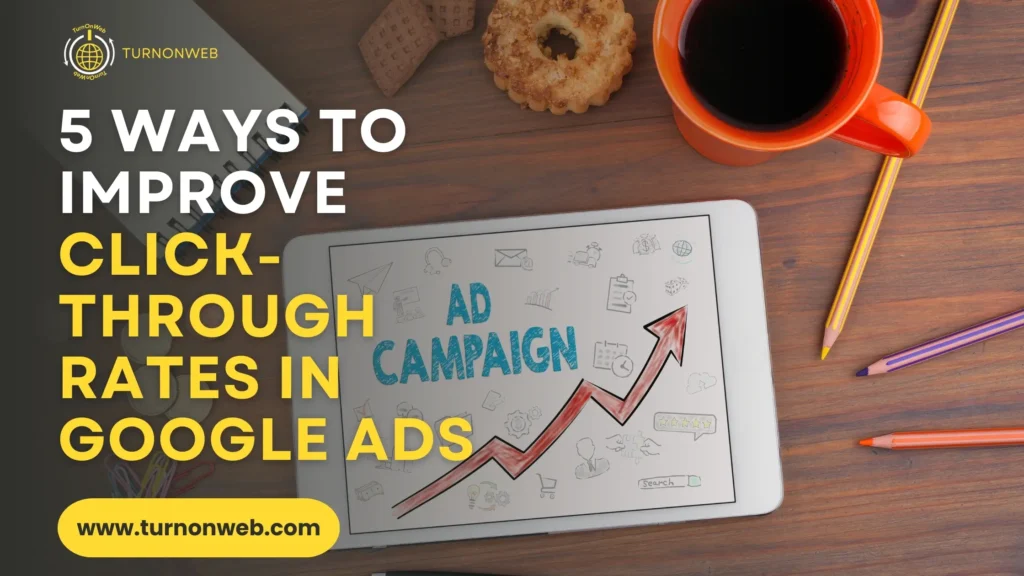Boost Your Google Ads CTR with 5 Effective Strategies for Success

Key Takeaways
- Effective ad copywriting can significantly improve CTR.
- Utilizing ad extensions provides more information and appeal.
- Proper keyword selection ensures relevance and visibility.
- Crafting compelling call-to-actions (CTAs) encourages clicks.
- Regular A/B testing helps optimize ad performance.
Why Click-Through Rates (CTR) in Google Ads are Important?
When it comes to Google Ads, the click-through rate (CTR) is a crucial metric that can make or break your advertising campaigns. A higher CTR not only indicates that your ads are relevant and engaging but also contributes to better ad performance and increased conversions. So, how can you improve your CTR and ensure your ads are hitting the mark? Let’s dive into some proven strategies that can help you boost your Google Ads CTR and drive more successful campaigns.
Related: Creating Effective PPC Strategies with Google Ads: A Comprehensive Guide
Understanding Click-Through Rates in Google Ads
Click-through rate (CTR) is the ratio of users who click on your ad to the number of times your ad is shown (impressions). It’s a crucial metric because it directly impacts your ad’s ranking and cost-per-click (CPC). Higher CTRs mean your ads are relevant to users, which can lead to better ad positions and lower costs.
CTR is essential for:
- Ad Ranking: Google uses CTR as a factor in determining your ad’s position. Ads with higher CTRs often get better placements.
- Cost Efficiency: Higher CTRs can lead to lower CPCs because Google rewards ads that generate more clicks with lower costs.
The Importance of Ad Copy
Writing Compelling Headlines
Your ad’s headline is the first thing users see, so it needs to grab their attention immediately. Use strong, action-oriented language and include keywords that are relevant to your audience. For example, instead of “Great Deals on Laptops,” try “Save Big on Top-Brand Laptops Today!”
Using Emotional Triggers
Emotional appeal can significantly increase CTR. Craft headlines and descriptions that evoke emotions like curiosity, excitement, or urgency. Phrases like “Don’t Miss Out” or “Limited Time Offer” can prompt users to click.
Incorporating Keywords
Including relevant keywords in your ad copy ensures that your ad appears in the right search queries. This not only improves relevance but also enhances your Quality Score, leading to better ad placements.
If you are facing a problem with Google Ads setup you can visit here for help.
Leveraging Ad Extensions
Types of Ad Extensions
Ad extensions provide additional information and increase the size of your ad. Here are some types to consider:
- Sitelink Extensions: Add extra links to specific pages on your website.
- Callout Extensions: Highlight unique offers or selling points.
- Structured Snippet Extensions: Provide a preview of products or services.
- Call Extensions: Include a phone number to encourage direct calls.
Benefits of Using Ad Extensions
Ad extensions can significantly increase your ad’s visibility and CTR by providing more space and information. They make your ad more appealing and give users more reasons to click.
Best Practices for Implementing Ad Extensions
Ensure your ad extensions are relevant to your ad copy and provide real value to your audience. Regularly update them to reflect new offers or changes in your business.
Related: Optimizing Your Website to Align with Google’s EEAT Guidelines
Keyword Selection Strategies
Conducting Keyword Research
Effective keyword research is essential for targeting the right audience. Tools like Google Keyword Planner, SEMrush, and Ahrefs can help identify high-performing keywords. Focus on keywords with high search volume and low competition.
Using Long-Tail Keywords
Long-tail keywords are more specific and less competitive, often resulting in higher CTRs. For instance, instead of targeting “shoes,” use “women’s running shoes.”
Negative Keywords
Negative keywords prevent your ads from showing up in irrelevant searches, improving your CTR and saving your budget for more relevant clicks. Regularly review and update your negative keyword list.
Crafting Effective Call-to-Actions (CTAs)
A strong call-to-action (CTA) is vital for driving clicks. Your CTA should clearly tell users what action you want them to take and create a sense of urgency or value. Here are some tips for crafting effective CTAs:
- Be Direct and Clear: Use action verbs like “Shop Now,” “Learn More,” or “Get Started” to indicate the desired action clearly.
- Create Urgency: Phrases like “Limited Time Offer,” “Act Now,” or “Don’t Miss Out” can encourage users to click immediately.
- Highlight Benefits: Emphasize what the user will gain by clicking, such as “Free Trial,” “Exclusive Discount,” or “See Our Latest Collection.”
- Align with Your Campaign Goals: Ensure your CTA matches the overall objective of your ad campaign, whether it’s driving sales, generating leads, or increasing website traffic.
Incorporate your CTA prominently in your ad copy, making it stand out and easy to notice.
A/B Testing for Optimization
What is A/B Testing?
A/B testing involves comparing two versions of an ad to see which performs better. This method helps optimize your ads by identifying the most effective elements.
How to Conduct A/B Tests
- Create Variations: Develop two versions of your ad with a single differing element (e.g., headline or CTA).
- Run Tests Simultaneously: Ensure both ads run at the same time for accurate comparison.
- Analyze Results: Compare the performance metrics to identify the better-performing ad.
Analyzing Test Results
Look at metrics like CTR, conversion rate, and CPC to determine which ad variation is more effective. Use these insights to refine your ads.
Visit here to get more detail.
Monitoring and Adjusting Your Ads
Regular Performance Reviews
Regularly review your ad performance to identify trends and areas for improvement. Tools like Google Analytics can provide valuable insights.
Making Data-Driven Adjustments
Use the data from your performance reviews to make informed adjustments to your ads. This might include tweaking ad copy, adjusting bids, or updating keywords.
Staying Updated with Google Ads Features
Google Ads frequently updates its features. Staying informed about new tools and options can help you stay ahead of the competition and optimize your ads effectively.
Related: Google March 2024 Update: 5 SEO Hacks to Outsmart Google
Conclusion
Improving your Google Ads click-through rates (CTR) is essential for maximizing your online advertising success. From crafting compelling ad copy and leveraging ad extensions to conducting thorough keyword research and A/B testing, these strategies can significantly boost your ad performance and drive more traffic to your website.
At TurnOnWeb, a leading website development company in Pune, we understand the complexities of digital marketing and the importance of a high CTR. Our team of experienced professionals can help you implement these strategies effectively. Here’s how TurnOnWeb can assist you:
- Expert Ad Copywriting.
- Strategic Use of Ad Extensions.
- Comprehensive Keyword Research.
- Crafting Compelling CTAs.
- Continuous A/B Testing and Optimization.
Improving your Google Ads CTR is not a one-time effort but a continuous process of optimization and refinement. Let TurnOnWeb help you achieve your digital marketing goals with our expertise and dedication to excellence. Contact us today to learn more about how we can enhance your Google Ads campaigns and drive your business success.
People Also Ask
1. What is a good CTR for Google Ads?
A good CTR varies by industry, but generally, a CTR of 2-3% is considered average. Strive for higher CTRs to maximize ad performance.
2. How do ad extensions improve CTR?
marketing objectives?
Ad extensions provide additional information and increase the size of your ad, making it more appealing and likely to be clicked.
3. Why is keyword selection important for CTR?
Selecting relevant keywords ensures your ads are shown to the right audience, improving the chances of getting clicks.
4. How often should I conduct A/B testing?
Conduct A/B testing regularly, especially when launching new campaigns or making significant changes to existing ones. Regular testing helps optimize ad performance.
5. Can I improve CTR without increasing my ad budget?
Yes, you can improve CTR by refining ad copy, using ad extensions, selecting better keywords, and testing different CTAs without necessarily increasing your budget.
- QUICK LINKS
TurnOnWeb Solutions - Zoho's Partner
- QUICK LINKES
- SERVICES




